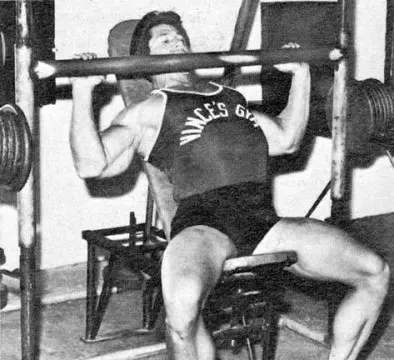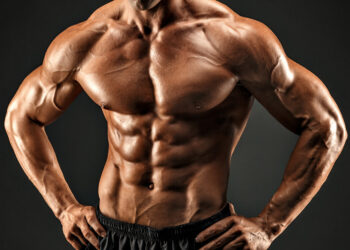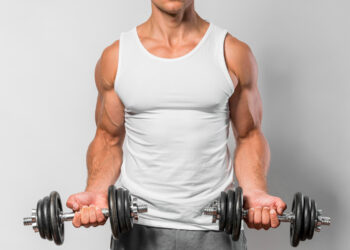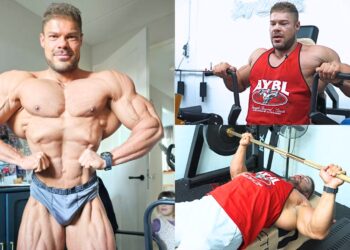For better or for worse, training your chest has, for many individuals, become synonymous with the bench press. Remarkably given the popularity of chest day for countless lifters, we are, as a community, rather unoriginal when it comes to training the chest. Many lifters, myself included, gravitate towards a trinity of bench press, dumbbell flies and cable crossovers.
Much like the forgotten leg exercises previously detailed on Fitness Volt, this lack of originality does a disservice to those who came before us. For decades, trainees and coaches experimented with a variety of angles, movements and exercises to fully engage the chest. Some of these exercises may appear odd to us in 2019 but their popularity spoke to their effectiveness.
Seeking to showcase some of bodybuilding’s forgotten chest exercises, today’s post examines three of the most important, and controversial exercises, that weight lifters have used to target their chest. We’ll run through their history, why they were created, and how you can include them in your own routines.
The Gironda Neck Press
Admittedly, anything with the term ‘Neck Press’ is likely to raise a few suspicious eyebrows and I suspect that’s exactly why Vince Gironda named his exercise as such. Gironda, for those unaware, was one of bodybuilding’s most successful and sought after coaches of the 1960s and 1970s. He helped popularize exercises like the ‘Sissy Squat’ and trained the first Mr. Olympia Larry Scott.
Needless to say, he was a man who knew a thing or two about gaining muscle. Such was Vince’s commitment to muscle building that he modified and even created several new exercises for bodybuilders to use. One such exercise was the Gironda neck press.
Level Up Your Fitness: Join our 💪 strong community in Fitness Volt Newsletter. Get daily inspiration, expert-backed workouts, nutrition tips, the latest in strength sports, and the support you need to reach your goals. Subscribe for free!
Vince was not a man shy about criticizing perceived bodybuilding truths. His distaste for the back squat led him to promote the Sissy Squat as a quad builder. Likewise, Vince was greatly suspicious of the traditional bench press which he believed built the deltoids and not the chest. For those suspicious or critical of Vince’s view, innumerable gym-goers with rounded shoulders and strong bench presses lends some truth to his claims. In any case, Vince’s ‘neck press’ was created to find a better way of isolating the chest and excluding the shoulders from too much involvement.(1) Such was Vince’s fondness for this exercise that he counted it among the most effective chest exercises in his ‘Bulk Course’, published in 1968.
Designed to target the upper part of the chest, Gironda described his exercise as follows
This exercise can be done with either a barbell or on the Smith machine. I prefer the machine because you don’t have to worry about balancing the bar and you can really focus your attention on the pecs.
Lie back on the bench. Cross your legs and lift them off the bench and draw them back over your stomach.
This position ensures perfect form and balance. This also ensures you cannot arch, as your back must remain flat on the bench. This increases the range of motion of the bar.
Take a wide grip on the bar and the elbows and upper arm should be directly under or slightly back of the barbell. Lower the bar to where your neck and upper chest meets – not to the nipple line as you would with regular bench presses.
Press up to within an inch of lockout and then lower and repeat.
Try for maximum stretch as you lower the bar and tense the pecs hard at the top, trying for a hard contraction … (2)
Interestingly Bret Contreras (‘The Glute Guy’) found the neck press to be one of the most effective chest exercises available to gym-goers. Writing for T-Nation in 2011, Contreras compared 20 different chest exercises in a bid to determine the best exercises for the lower, middle and upper portions of the chest. His conclusion?
That the neck press or ‘guillotine’ press is superior for pectoral activation than many other exercises, including the incline bench press.(3)
Gironda’s exercise is not one designed for large amounts of weight. Returning to Vince’s prescriptions, the ‘Iron Guru’ as he was termed, encouraged trainees to
Use a weight that is 50 percent of your maximum on the first set of 10 reps. The second set use a weight that is 75 percent of your maximum for eight reps. The third set use a weight that is 100 percent of your maximum for 6 reps. Reduce the weight the fourth set and pump out 15 reps to flush the area with blood. Rest less than 45 seconds between each set …(4)
Turning to your own training, how and why should one incorporate the neck press? In the first instance, the neck press, as shown in Bret Contreras’ research, is an effective substitute for the incline bench press. High reps works well and, perhaps obviously given the form, controlled tempos are necessary. That being said, the neck press marks a challenging and criminally underrated exercise for modern gym-goers.
Reverse Grip Bench Press
Now if the thought of the neck press is making your shoulders hurt, the reverse grip bench press (RGBP) offers the best remedy. Although this exercise is likely rarely seen in the gym in 2019, the RGBP represents a clever twist on the regular bench press. It provides a nice change in one’s training and, more importantly, places far less stress on the shoulders than many conventional chest exercises.
Now the RGBP is exactly what it sounds like in terms of technique. When gripping the bar, lifters take a supinated or reverse grip. This means that, in effect, the knuckles face towards you, rather than away. Aside from that, the movement will be familiar enough and, much like our neck press exercise outlined above, studies conducted on the RGBP found that it stimulates the pectorals far more (around 30%) than the incline bench press.(5) It was also found to place less strain on the shoulders and even stimulate the triceps more than the average bench press. For these reasons alone, it’s worth examining at least.
Unlike the regular bench press, whose history dates over a century, the RGBP is a relatively new invention. The RGBP, or at least its popularization, dates to the 1980s. This was the period when Arnold Schwarzenegger’s starring role in ‘Pumping Iron’ helped to popularize bodybuilding in American society.(6) In gyms across the United States, individuals took to the gym in a desperate bid to become the next Arnold. One such duo were the Paul brothers, Peter and David.
Known fondly for their collective nickname, the ‘Barbarians’, the two brothers gained a great deal of attention during the 1980s for their unmatched intensity in the gym and also their outlandish public appearances. Wearing t-shirts with slogans such as ‘not till you cry’ or ‘train till you die’, the Barbarians were some of the most outlandish bodybuilders of the 1980s.
Reporting on the brothers in Sports Illustrated, Bob Ottum claimed that
Level Up Your Fitness: Join our 💪 strong community in Fitness Volt Newsletter. Get daily inspiration, expert-backed workouts, nutrition tips, the latest in strength sports, and the support you need to reach your goals. Subscribe for free!
Peter and David don’t really train, they rampage. They invade the gym, falling upon huge weights and lifting them and then piling on more weights. They lurch from station to station with a rolling, top-heavy gait, often growling loudly as they go. When they are under enormous stress, perhaps a bench press with 500 pounds of iron held overhead, their roars of effort rattle the big windows at Gold’s … (7)
As part of their desire to continually lift heavier weights, the brothers, perhaps unsurprisingly, incurred a number of injuries. In particular, their shoulders were giving up on them. Refusing to give up their intensity in the gym, they began to tweak their exercises.
Hence the birth of the RBGP. Once discovered, the RGBP was an instant hit with the two barbarians. According to one story, the brothers pressed 315 lbs for 27 reps using a reverse grip. When asked why they used such a heavyweight, the brothers responded that it was their warm-up! (8)
From the Barbarians, the lift grew in popularity. In 1993, Doug Daniels wrote that
There are a lot of assistance exercises available, some productive, some not so productive. One assistance exercise that may have benefits is the reverse grip bench press. Simply put, the reverse grip bench is a bench press with your grip going the opposite way – that is, knuckles facing your feet. I first heard of this exercise in Muscle & Fitness. There was a picture of the famous Paul Brothers, the Barbarians, doing reverse grips.
They put on exhibitions and routinely reverse grip bench over 500 pounds. At first, I considered the exercise a novelty. Later, 275’er Bill Nichols told me in an interview that after Rick Weil suggested he add them to his bench training, his max bench went up when no other technique seemed to work. Lately, Anthony Clark has been benching massive weights in competition using a reverse grip. I am not suggesting using the reverse grip at a meet, but I am suggesting we may have something here … (9)
Anthony Clark, the great American powerlifter used the RGBP for many years, even benching over 700 lbs. using a reverse grip, but the exercise has fallen massively out of favor for gym-goers.(10) This I believe, is a real shame. Aside from providing some nice variation in your training, the RGBP is a great exercise for those with shoulder problems. For a biomechanical reason which I am far too ignorant to understand, I can often press heavy with the RGBP when a regular bench press is causing my shoulders to cry out in pain.
For those seeking to become ‘barbarians’ in their own right, what’s the best method of incorporating the RGBP? Unlike the neck press which is best done at a lighter weight, I’ve found the RGBP works well using heavier weights. The only thing lifters should be conscious of is the position of the wrists when performing the RGBP. Inexperienced trainees often allow the wrists to slack back, which can be dangerous when heavyweights are involved. Instead, keep the wrists relatively rigid and press to your heart’s content.
Now obviously any discussion of the RGBP and the ‘Barbarian’ brothers would not be complete without a video of the two men performing the lift in a very strange setting. Enjoy!
Straight Arm Pullover
The last exercise is likewise one unlikely to be found in your gym. This does not mean, however, that it’s not effective. The traditional pullover exercise is one which tends to divide opinion across gym floors.(11) For some, the exercise marks a great method of targeting the chest and, if done in a certain way, the back. For others, the traditional dumbbell pullover spells disaster for their shoulders.
Much like the neck press and the RGBP, it is best to experiment and discover what works best for one’s own body. Missing from all of these debates, however, is the straight arm pullover using a light barbell. For much of the twentieth century, the two arm pullover was one of the most popular exercises for developing the chest.
Evidence of lifters using the two arm pullover dates to the late nineteenth century. For us today, the most important work was Alan Calvert’s 1924 Super Strength, which helped popularise the lift to an even greater audience. (12) Kim Beckwith’s work on Calvert marked him as one of the most important voices in American health and fitness in the early 1900s. (13) He founded one of America’s first barbell companies in Milo Barbell (established in 1902) and created one of America’s first weightlifting magazines in Strength magazine (founded in 1914). All of this is my way of telling you that when Calvert wrote something, people took notice. Regarding the two arm pullover, Calvert had this to say
Any man who can raise a 100-lb. bar-bell from the floor to above his chest with straight arms, is very unusually strong. I have heard stories of men raising 150 lbs. in this way, but I have never seen anyone do more than 120 lbs.
If you fail to get results from practicing, the fault is not with the exercise but with you. In the first place, the arms must be stiff and straight, and that means that they must not be bent the least trifle at the elbows.
I have seen men do the exercise with the arms slightly bent at the elbow; and be- cause they didn’t bend the arms any further while raising the bell, they would insist that their arms were straight.
The moment you bend the arms at the elbow, you throw more work on arm muscles and less on the muscles which control the ribs. The correct way is to lower the bell slowly; and as you lower it, you must take a deep breath and spread the ribs as far apart as possible. As you raise the bell, you breathe out. It is a vital mistake to use too much weight or to count the repetitions … (14)
For those following Calvert in the 1930s and 1940s, men like Mark Berry and Peary Rader, the two arm pullover marked a cornerstone of their muscle gaining protocols. Both Berry and Rader promoted 20 rep squats with a heavyweight as a means of increasing one’s body weight and muscle mass.(15) The program was seen as effective only if the high repetition squatting was paired with two arm pullovers.
Thus thousands of gym-goers in the first half of the twentieth century used the two arm pullover. Why the exercise fell out of use is something I have yet to discover. What I suspect is that, much like the traditional dumbbell pullover, concerns about shoulder health impacted the lifts’ popularity.
It is for this reason that interested readers heed Calvert’s warnings about technique. Done correctly, that is with straight arms and a good deal of focus, the two arm pullover will stretch and strain the muscles in a way other chest exercises simply don’t. Done incorrectly and your shoulders will hurt, fast. From early trainees like Calvert, Berry, and Rader, the advice was simple. Use a relatively lightweight, keep your arms straight at all times and focus on your chest throughout the lift. You’ll soon discover why so many gym-goers used the exercise for close to seventy years.
Changing Your Training
Now admittedly chest day is probably everyone’s favorite training session. Tough as it may be, chest day is a time for our egos and our imaginations to run wild with the ‘pump’. It’s strange to think then that so many trainees use the same exercises over and over again in their training. Being the very impatient and easily bored trainee that I am, I need new exercises, new techniques, and new angles to keep my training fresh.
Luckily for me, the history of bodybuilding and physical culture provides dozens upon dozens of new exercises to choose from. The ones featured in today’s article are, in my own experience, among the most effective, and indeed fun to use, when training the chest.
Gironda’s neck press may look strange but it’s more effective than the incline bench in hitting the pectorals. The Barbarian Brothers’ reverse grip bench press comes to the rescue when our shoulders start troubling us. Finally, the two arm pullover provides a new way and new means of targeting the chest. If variety is the spice of life, it’s equally true that the importance of variety extends to our training.
References
- Randy Roach, Muscle, Smoke and Mirrors Volume 1 (Bloomington, 2008), 471.
- ‘The Vince Gironda Neck Press’. Ironguru.com. Available at http://ironguru.com/the-vince-gironda-neck-press/.
- Bret Contreas, ‘The Best Damn Bench Press Article Period.’ 15 December 2011, T-Nation. Available at https://www.t-nation.com/training/best-damn-bench-press-article-period.
- Vince Gironda, Master Series Volume 4 (Venice Beach, n/d), 4.
- Jim Stoppani, ‘Reverse Grip Bench Press Master Class.’ 14 May 2019, Jim Stoppani. Available at https://www.jimstoppani.com/training/reverse-grip-bench-press.
- Ellexis Boyle, ‘Marketing muscular masculinity in Arnold: the education of a bodybuilder.’ Journal of Gender Studies 19, no. 2 (2010): 153-166.
- Bob Ottum, ‘Honin’ the Barbarians’, Sports Illustrated, 28 June, 1982.
- Conor Heffernan, ‘History of the Reverse Grip Bench Press.’ Physical Culture Study.
- Doug Daniels, ‘Reverse Grip Bench Press.’ The Tight Slacks of Dezso Ban. Available at http://ditillo2.blogspot.com/2017/02/reverse-grip-bench-press-doug-daniels.html.
- Ibid.
- Chris J. Durall, Robert C. Manske, and George J. Davies. ‘Avoiding shoulder injury from resistance training.’ Strength & Conditioning Journal 23, no. 5 (2001): 10-18..
- Alan Calvert, Super Strength (Philadelphia, 1924), 37-38.
- Kimberly Ayn Beckwith, ‘Building strength: Alan Calvert, the Milo Bar-bell Company, and the modernization of American weight training’ (PhD diss., University of Texas, 2006).
- Calvert, Super Strength, 37-38.
- Peary Rader, The Rader Master Builder and Weight Gaining System (Nebraska, 1946).









